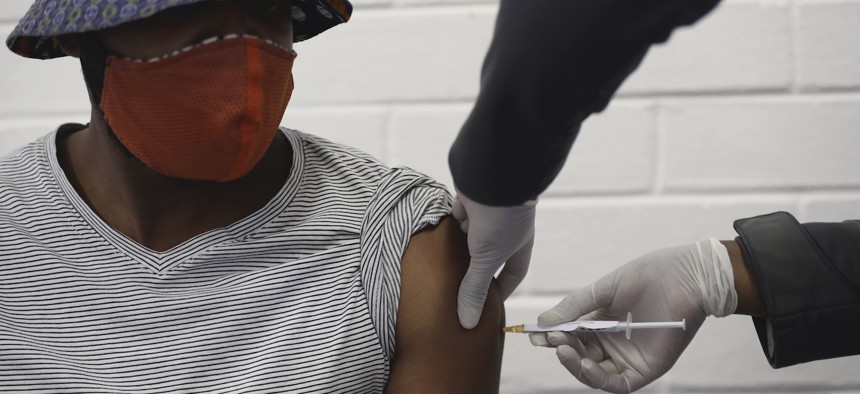
A vaccine volunteer gets an injection at the Chris Hani Baragwanath hospital in Soweto, Johannesburg Wednesday, June 24, 2020. AP Photo/Siphiwe Sibeko
White House ‘Very Confident’ on Coronavirus Vaccine By Year’s End. But Supply Questions Remain
Officials say at least one vaccine candidate will soon move to Phase III trials.
The effort to produce a COVID-19 vaccine and better treatments by year’s end is on track, a White House senior official said Monday.
Within weeks, Phase III clinical trials will begin for at least one of the several vaccine candidates developed by Operation Warp Speed,, a collaboration between the Defense Department, National Institutes of Health, and other agencies, the official told reporters.
“The current outbreaks may help us get a vaccine faster than if we had no outbreaks,” he said on condition of remaining unnamed.
The reason: clinical trials need 30,000 participants and must take place in locations where outbreaks are occuring. The unexpected surge in cases over the summer mean those two conditions are now easier to meet.
The official said that Warp Speed managers are “very confident” and “encouraged by the early data” that came in last week on vaccine candidates. He also said a number of manufacturing sites will be ready to begin production of vaccines within four to six weeks.
“We feel very confident that by the end of the year we will have tens of millions of vaccines to put into American arms,” he said.
OWS is also working on antibody-based therapeutics: medicines that could lessen the effects of the virus, including some that could be applied prophylactically (before a patient gets sick. These would work like mini vaccines, shielding vulnerable populations such as medical workers unlike a vaccine becomes available. The official said he hopes to have these in the fall.
More than 50 of these therapeutics efforts are based on monoclonal antibodies “because the tech has advanced so much,” enabling “rapid” increases in production, Janet Woodcock, the director of the Center for Drug Evaluation and Research at the U.S. Food and Drug Administration told reporters.
Highly potent monoclonal antibodies are playing a big role in that push for therapeutics. There are currently more than 50 monoclonal antibody programs ongoing “because the tech has advanced so much,” enabling “rapid” increases in production, Janet Woodcock, the director of the Center for Drug Evaluation and Research at the U.S. Food and Drug Administration told reporters.
Later this month, OWS will begin clinical evaluation of various therapeutics with two master protocols, one for outpatient subjects and inpatient subjects, enabling researchers to “evaluate multiple antibodies in the same trial,” she said.
But some scientists, including at Duke University, have said it’s unlikely that a vaccine will be widely available by year’s end, let alone to meet a demand that could reach 25 million doses.
The U.S. simply lacks the capacity to produce vaccines that quickly. A small Canada-based company called Medicago, which has received DARPA funding for its innovative approach to vaccine production, is trying to change that. The company essentially inserts a DNA sequence into soil bacteria and then grows plants (a cousin of the tobacco plant) that can be turned into vaccine doses. They project that they'll eventually be able to produce ten million doses a month by the end of 2021.
On Tuesday, company officials announced that they had begun Phase I clinical trials of their vaccine candidate. Medicago CEO Dr. Bruce Clark said that the firm has been in contact with Operation Warp Speed and has “had great discussions and interactions with their leadership.”
But they remain a relatively small player in the vaccine biotechnology industry. “The concern from a company like ours, it’s difficult for us to get the attention of the funding agencies,” said Clark, noting that they have to compete for attention with other, much larger companies that aren’t necessarily the most innovative players in the field.
“New technology doesn’t always come from the big players…Let’s not perpetuate a model shown to be predictable,” he said of the current approach to vaccine development. “It produces something; but it’s not a step change, not changing the game. Companies like ours can change the game.”
NEXT STORY: Peter Thiel’s New Man In The Defense Department
